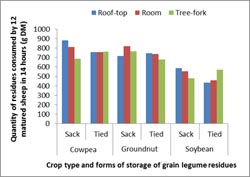Crop residues are an important livestock feed resource and as such they are linking crop and animal production in West Africa. They are the second largest feed source for livestock after grazing, especially in the dry season in the savannas.
Grain legume residues (GLRs) such as those of groundnut, cowpea and soyabean are considered more valuable feed resources than cereal crop residues, since they have higher nitrogen contents and digestibility. Moreover, inclusion of small quantities of GLRs in cereal-straw based rations of ruminants may improve intake and utilization of the low quality feeds by supplying the limiting nitrogen, and hence contribute to improved animal production.
Experiments are currently being conducted to investigate the traditional storage systems of grain legume residues for livestock feed in northern Ghana.
The objectives of trials are:
- Study the feed quality degradation in traditional storage systems of GRLs for livestock feeding;
- Study the effects of different storage systems and length of storage on quality and palatability of GRLs;
- Determine the animal preference for stored GRLs over time;
- Determine farmers’ preference for the GRLs storage systems.
The experimental design used was a split-split plot design with 18 observations replicated four times in different communities (farms). The treatments included: whole plot - 3 types of storage locations (rooftop, tree fork and room), sub plot - 3 types of grain legume residues (cowpea, groundnut and soyabean) and sub-sub plot - 2 types of packing (sacks and tied with ropes). Figure 1 shows the three types of storage locations.
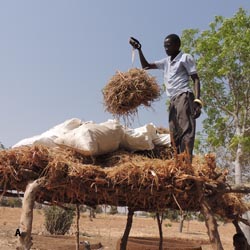 |
 |
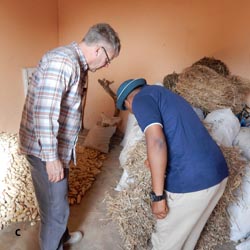 |
Figure 1: Three types of storage locations of the GLRs, A = Rooftop, B = Tree fork and C = Room (Photo Daniel Brain Akakpo, 2016)
Data collected during storage are monthly weight loss and weekly temperature in the heaps and sacks. Stored GLRs are sampled monthly to evaluate fodder quality, using quality indicators such as crude protein (CP), neutral detergent fibre (NDF), Acid detergent fibre (ADF), in-vitro digestibility and leaf-stem ratio. Physical quality of stored GLRs was also evaluated by farmers and through palatability tests with sheep (Figure 2).
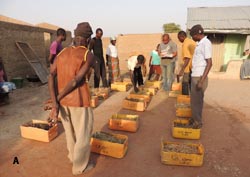 |
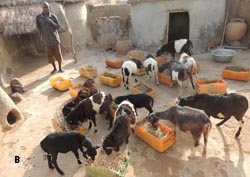 |
Figure 2: Evaluation of stored GLRs after two months of storage by; A = Farmers and B = Animals (sheep) (Photo Daniel Brain Akakpo, 2016) |
|
Preliminary results indicate that farmers prefer cowpea residue as feed source for their animals to groundnut and soyabean residues. Palatability tests (1 kg GLR of each treatment was served in a cafeteria manner to 12 mature sheep during 14 hours and intake of each was recorded) indicated that there was significant difference (P<0.05) in quantity of residues consumed by animals among GLR types (Figure 3). Animals prefer cowpea residues more to the rest of the residues. The fodder quality assessed by laboratory measures and leaf-stem ratio will be used to explain the ranking and the selection made by the farmers and animals, respectively. The outcomes of the present study will be discussed with farmers and we hope that farmers will learn from it and adopt the best practice. |
Figure 3: Effect of type of storage location, GLR type and type of storage on quantity of residue consumed by 12 matured sheep in 14 hours in a palatability test (Daniel Brain Akakpo, 2016) |
Daniel Brain Akakpo

